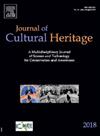庞贝考古公园新出土精美彩绘天花板的分析研究
IF 3.3
2区 综合性期刊
0 ARCHAEOLOGY
引用次数: 0
摘要
这项工作涉及对庞贝考古公园(意大利那不勒斯)第九岛区(Regio IX insula 10)挖掘期间发现的碎片彩绘天花板的现场和实验室研究。这幅作品以第四庞贝风格绘制,具有独特的艺术品质,至今仍保持着非凡的色彩生动。对壁画碎片的诊断研究旨在确定原材料的质量和制作技术是否符合艺术品的风格质量,并评估新出土壁画的保存状况。原位光谱技术(x射线荧光、拉曼和傅里叶变换红外光谱技术)的结果表明存在多种颜料。其中,朱砂的使用被认为是罗马人使用的最昂贵的颜料之一,进一步凸显了这幅壁画的卓越品质。此外,在发现埃及蓝和孔雀石的一些地区,还发现了一种不同寻常的制作技术,包括在表面涂上颜料颗粒。利用扫描电子显微镜(SEM)和能量色散x射线能谱(EDS)对两种微样品进行了研究,使研究执行技术成为可能。此外,对横截面的观察和有机物质痕迹的检测表明,壁画是用塞科技术实现的。从三个预备层(壁画的支撑层,arriccio和intonachino)中取样,进行x射线衍射分析和可溶性盐提取,然后进行离子色谱分析。最后一种技术获得的结果显示可溶性盐含量低,表明不需要修复器进行预防性盐提取干预。本文章由计算机程序翻译,如有差异,请以英文原文为准。

Analytical study of a newly excavated fine painted ceiling at the Archaeological Park of Pompeii
This work concerns an in situ and laboratory study of a fragmented painted ceiling found during the excavations in the Regio IX insula 10 of the Archaeological Park of Pompeii (Naples, Italy). This artwork was painted in the Fourth Pompeian style of a unique artistic quality that still maintains a remarkable chromatic vividness. The diagnostic study of the painted fragments aimed to determine whether the quality of the raw materials and execution technique aligned with the artwork's stylistic quality, and to assess the conservation state of the newly excavated wall paintings. The results of the in situ spectroscopic techniques (X-ray fluorescence, Raman and Fourier-transform infrared spectroscopy techniques) showed the presence of a variety of pigments. Among them, the use of cinnabar, considered one of the most expensive pigments used by the Romans, further highlights the superior quality of the retrieved mural painting. Additionally, an unusual execution technique, involving the application of pigment grains on the surface, has been identified in some areas where Egyptian blue and malachite were found. The study of two micro samples by means of Scanning electron microscopy (SEM) and energy dispersive X-ray spectroscopy (EDS) has made possible to investigate the execution techniques. In addition, the observation of the cross sections and the detection of traces of organic material suggested that the wall paintings were realized with secco technique. Fragments from the three preparatory layers (support of the mural painting, arriccio and intonachino) were sampled to perform X-Ray diffraction analysis and extraction of soluble salts followed by ion chromatography analysis. The results obtained with this last technique showed a low content of soluble salts, suggesting that a preventive salt extraction intervention does not need to be performed by restorers.
求助全文
通过发布文献求助,成功后即可免费获取论文全文。
去求助
来源期刊

Journal of Cultural Heritage
综合性期刊-材料科学:综合
CiteScore
6.80
自引率
9.70%
发文量
166
审稿时长
52 days
期刊介绍:
The Journal of Cultural Heritage publishes original papers which comprise previously unpublished data and present innovative methods concerning all aspects of science and technology of cultural heritage as well as interpretation and theoretical issues related to preservation.
 求助内容:
求助内容: 应助结果提醒方式:
应助结果提醒方式:


